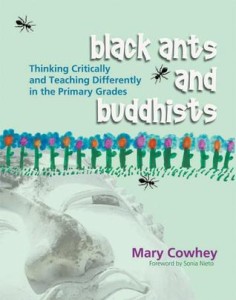Black Ants and Buddhists
Author: Mary Cowhey
Published: January 1st, 2006 by Stenhouse Publishers
Summary: What would a classroom look like if understanding and respecting differences in race, culture, beliefs, and opinions were at its heart? Welcome to Mary Cowhey’s Peace Class in Northampton, MA, where first and second graders view the entire curriculum through the framework of understanding the world, and trying to do their part to make it a better place.
Woven through the book is Mary’s unflinching and humorous account of her own roots in a struggling large Irish Catholic family and her early career as a community activist. Mary’s teaching is infused with lessons of her heroes: Gandhi, Eleanor Roosevelt, Helen Keller, Martin Luther King, and others. Her students learn to make connections between their lives, the books they read, the community leaders they meet, and the larger world.
If you were inspired to become a teacher because you wanted to change the world, and instead find yourself limited by teach-to-the-test pressures, this is the book that will make you think hard about how you spend your time with students. It offers no easy answers, just a wealth of insight into the challenges of helping students think critically about the world, and starting points for conversations about diversity and controversy in your classroom, as well as in the larger community.
Review and Teacher’s Tools for Navigation: Mary Cowhey’s book is a phenomenal resource for teachers. It is directed for elementary school educators, but I learned a lot, and I am a high school educator. Her main focus is to promote social justice, action, and independence in the classroom. Cowhey integrates stories from her personal life (she grew up without much money and as an adult, was a single mother on welfare) into her lessons to show how she helps her students feel comfortable and safe when sharing their own experiences. She teaches them that regardless of their social or economic standing, they have the ability to be successful.
Each chapter addresses important issues that teachers face, such as how to: set routines, differentiate, respond to tragedy, teach history so kids care, build trust with families, and go against the grain. When her students were dissatisfied with something, she had them write letters. They became young advocates. Cowhey has an extremely responsive classroom, where she takes the students’ interests and teaches different aspects of history, literature, and life each year. Some may find her ideas to be a bit liberal, but they are certainly adaptable for more conservative classrooms. Her students learn in the field, walking to see the mayor to demand a change in their town or visiting a sanitation company when a student wondered, “Where do the poops go?”
What I loved most about Cowhey’s book is that it showed me how to make my students more in-tune with their surroundings. I would love to have my own child in her classroom, as I know he or she would learn a lot about self-advocacy.
Discussion Questions: How do I teach my students to value social justice?; How do I create a culturally responsive and socially responsive classroom?; How do I make class meaningful for my students?; How do I create a safe and comfortable place for my students?; What do I do when students are distracted while I am trying to teach a concept?
We Flagged: “How we respond to tragedy, as teachers, as parents, as humans, not only provides comfort and security, but also can provide hope and power for children in a world that is often unfair, and sometimes unspeakably violent” (181).
Read This If You Loved: Reading, Writing, and Rising Up: Teaching about Social Justice and the Power of the Written Word by Linda Christensen, Pedagogy of the Oppressed by Paulo Freire, Teachers as Cultural Workers by Paulo Freire
What is your favorite book for professional development? Have you read this one? What did you think? Please share your thoughts!


1 thought on “Black Ants and Buddhists by Mary Cowhey”